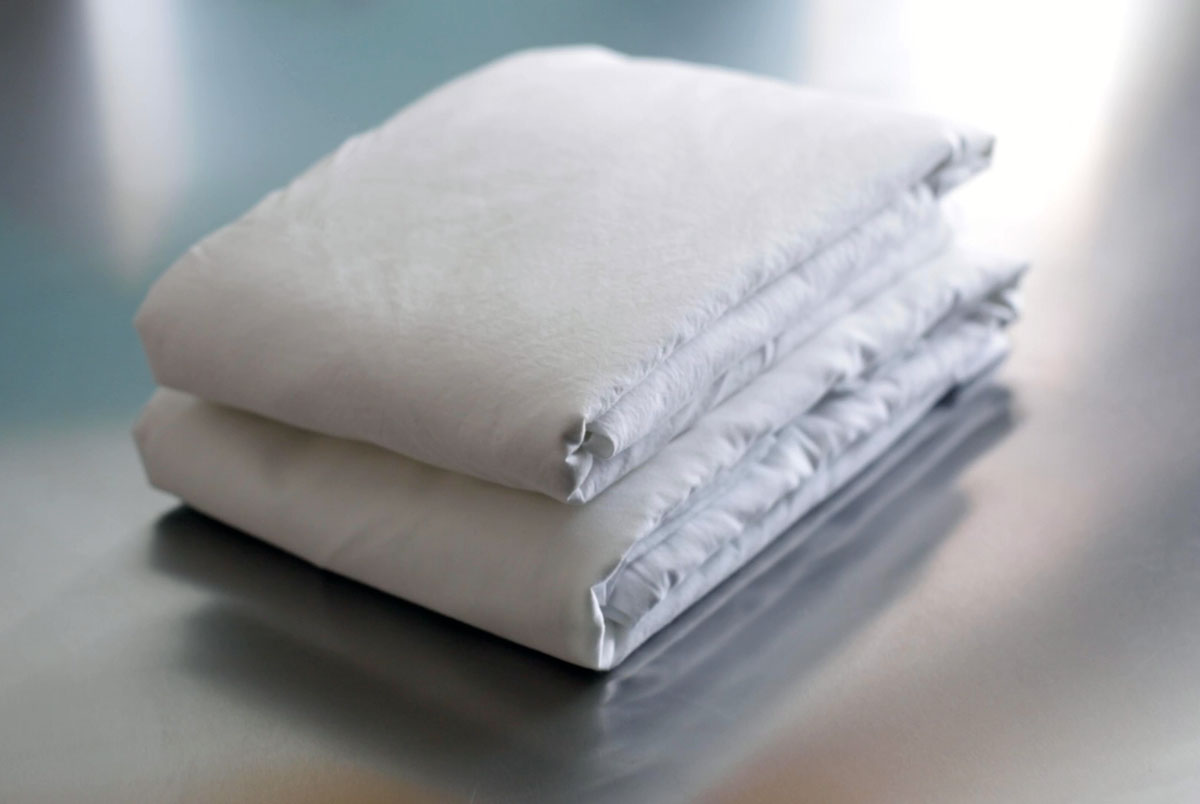Home>Furniture>Bedroom Furniture>What Setting To Wash Bed Sheets


Bedroom Furniture
What Setting To Wash Bed Sheets
Modified: August 28, 2024
Unsure of the best setting to wash your bed sheets? Discover expert advice and recommendations for washing bedroom furniture to ensure optimal cleanliness and longevity.
(Many of the links in this article redirect to a specific reviewed product. Your purchase of these products through affiliate links helps to generate commission for Storables.com, at no extra cost. Learn more)
Introduction
When it comes to creating the perfect sleep environment, we often focus on finding the right mattress, pillows, and decor. However, one crucial element that is often overlooked is the bedding itself, especially the humble bed sheets. Bed sheets not only contribute to the aesthetic appeal of your bedroom, but they also play a vital role in ensuring a comfortable and hygienic sleep experience.
Properly washing your bed sheets is essential to maintain their longevity, freshness, and cleanliness. However, with the wide variety of bedding materials available, it can be confusing to determine the appropriate washing settings for each type. In this article, we will explore the different bed sheet materials and provide recommendations on how to wash them to keep them looking and feeling their best.
Key Takeaways:
- Properly washing and caring for bed sheets is essential for maintaining hygiene, durability, and comfort. Understanding the unique characteristics of different materials and following recommended washing settings can preserve the quality and longevity of sheets.
- By investing time and effort in proper washing and care, you can create a clean, fresh, and comfortable sleep environment that promotes better sleep and overall well-being. Implementing essential maintenance tips ensures the benefits of inviting bed sheets for years to come.
Read more: What Are Bed Sheets
Why Properly Washing Bed Sheets Matters
Properly washing bed sheets is not just about maintaining their aesthetic appeal; it is also crucial for your health and well-being. Here are a few reasons why it is important to pay attention to the washing of your bed sheets:
- Hygiene: Our bodies shed dead skin cells, sweat, and oils while we sleep. If left unwashed, bed sheets can become a breeding ground for bacteria, dust mites, and allergens, which can lead to skin irritations, allergies, and respiratory issues.
- Odor Control: Regular washing of bed sheets helps eliminate unwanted odors that can accumulate over time. This is especially important if you or your partner tend to sweat during sleep.
- Durability: Bed sheets that are not properly cleaned and cared for can deteriorate faster. Regular washing helps maintain the integrity of the fabric, extending the lifespan of your bed sheets.
- Aesthetics: Clean and well-maintained bed sheets contribute to a visually pleasing bedroom environment. The crisp and fresh feel of clean sheets can also enhance your overall comfort and relaxation during sleep.
- Peace of Mind: Knowing that your bed sheets are clean and free from dirt and bacteria provides peace of mind and promotes a more restful and rejuvenating sleep experience.
By giving proper attention to washing your bed sheets, you can enjoy a cleaner, more hygienic, and comfortable sleeping environment.
Understanding Different Bed Sheet Materials
Before diving into the recommended washing settings for different bed sheet materials, it’s important to have a basic understanding of the various types of fabrics commonly used for bed sheets. Each material has its own unique characteristics and requires specific care to maintain its quality. Here are some popular bed sheet materials:
- Cotton: Cotton is one of the most common bed sheet materials due to its breathability, durability, and softness. It is hypoallergenic and suitable for all seasons.
- Linen: Linen bed sheets are known for their natural texture, breathability, and moisture-wicking properties. They are ideal for warmer climates and tend to get softer with each wash.
- Silk: Silk is a luxurious and ultra-smooth fabric that is hypoallergenic and gentle on the skin. It regulates body temperature and is perfect for those with sensitive skin.
- Microfiber: Microfiber bed sheets are made from synthetic fibers that are tightly woven, resulting in a fabric that is lightweight, wrinkle-resistant, and easy to care for. They are an affordable alternative to natural fibers.
- Flannel: Flannel bed sheets are made from brushed cotton, creating a soft and cozy feel that is perfect for cooler weather. They provide excellent insulation and a warm, snug sleep experience.
Understanding the characteristics of each material will help you determine the appropriate washing settings to preserve the quality and longevity of your bed sheets. Now, let’s explore the recommended washing settings for each type of bed sheet material.
Recommended Washing Settings for Cotton Bed Sheets
Cotton bed sheets are highly popular due to their breathability, softness, and durability. To keep your cotton bed sheets looking and feeling their best, follow these recommended washing settings:
- Water Temperature: It is best to wash cotton bed sheets in warm water, around 40-60 degrees Celsius (104-140 degrees Fahrenheit). Avoid using hot water, as it can cause shrinkage and damage the fabric.
- Detergent: Use a mild, color-safe detergent that is suitable for cotton fabrics. Avoid using bleach or harsh chemicals, as they can weaken the fibers and cause discoloration.
- Washing Cycle: Choose a regular or gentle cycle on your washing machine to prevent excessive agitation. This will help maintain the fabric’s softness and prevent unnecessary wear and tear.
- Drying: It is best to tumble dry your cotton bed sheets on a low heat setting. Remove them from the dryer while they are still slightly damp to minimize wrinkles. Alternatively, you can hang them outdoors to air dry.
- Ironing: If desired, iron your cotton bed sheets on a medium heat setting while they are still slightly damp. This will help achieve a crisp, wrinkle-free appearance.
- Frequency: Ideally, wash your cotton bed sheets every one to two weeks to maintain cleanliness and freshness.
Following these washing settings will help preserve the quality, softness, and longevity of your cotton bed sheets, ensuring a comfortable and enjoyable sleep experience.
Recommended Washing Settings for Linen Bed Sheets
Linen bed sheets are known for their natural texture, breathability, and durability. To keep your linen bed sheets looking and feeling their best, follow these recommended washing settings:
- Water Temperature: Linen bed sheets can be washed in warm or cool water, around 30-40 degrees Celsius (86-104 degrees Fahrenheit). Avoid using hot water, as it can cause shrinkage.
- Detergent: Use a mild, phosphate-free detergent that is suitable for delicate fabrics. Avoid using bleach or harsh chemicals, as they can damage the fibers and affect the natural texture of the linen.
- Washing Cycle: Select a gentle or delicate cycle on your washing machine to minimize agitation. This will help preserve the softness and integrity of the linen fabric.
- Drying: It is best to air-dry linen bed sheets by hanging them outdoors or laying them flat on a clean surface. Linen has a tendency to shrink if exposed to high heat, so avoid tumble drying. By air-drying, you’ll also enhance the natural texture of the linen.
- Ironing: Linen bed sheets have a charming, relaxed look with natural wrinkles. However, if you prefer a smoother appearance, you can iron them on a medium heat setting while they are slightly damp.
- Frequency: Linen bed sheets do not require frequent washing. Washing them every 2-3 weeks is usually sufficient. Regular washing can make linen softer over time.
By following these washing settings, you can maintain the natural beauty and longevity of your linen bed sheets, ensuring a cozy and comfortable sleep environment.
Wash bed sheets in warm water to effectively remove dirt and bacteria without damaging the fabric. Use a gentle detergent and avoid overloading the washing machine to ensure a thorough clean.
Read more: What Are The Softest Bed Sheets
Recommended Washing Settings for Silk Bed Sheets
Silk bed sheets are luxurious, smooth, and delicate. To properly care for your silk bed sheets and preserve their beauty and softness, follow these recommended washing settings:
- Water Temperature: It is best to wash silk bed sheets in cold water, around 30 degrees Celsius (86 degrees Fahrenheit). Avoid using hot water, as it can damage the silk fibers.
- Detergent: Use a gentle, pH-neutral detergent specifically formulated for silk or delicate fabrics. Avoid using bleach, enzymes, or harsh chemicals, as they can weaken the silk fibers and cause discoloration.
- Washing Cycle: Select a delicate or hand wash cycle on your washing machine or wash the silk bed sheets by hand. If using a washing machine, place the sheets inside a mesh laundry bag to prevent tangling or snagging.
- Drying: Avoid tumble drying silk bed sheets, as it can damage the fabric. Instead, gently squeeze out excess water without wringing and then lay them flat on a clean towel to air dry. Alternatively, you can hang them to dry indoors away from direct sunlight.
- Ironing: If necessary, iron your silk bed sheets on a low heat setting or use a handheld steamer. Iron on the reverse side or place a thin cloth between the iron and the silk to protect the fabric.
- Frequency: Silk bed sheets do not need to be washed as frequently as other materials. Washing them every 3-4 weeks should be sufficient, unless there are spills or stains that require immediate attention.
By following these washing settings, you can maintain the luster, softness, and durability of your silk bed sheets, ensuring a luxurious and comfortable sleep experience.
Recommended Washing Settings for Microfiber Bed Sheets
Microfiber bed sheets are known for their softness, durability, and easy maintenance. To keep your microfiber bed sheets looking and feeling their best, follow these recommended washing settings:
- Water Temperature: Microfiber bed sheets can be washed in warm or cold water. However, using cold water can help prevent the fabric from shrinking or losing its softness.
- Detergent: Use a mild, liquid detergent that is suitable for delicate fabrics. Avoid using bleach or fabric softeners, as they can leave a residue on the microfiber and affect its absorbency and softness.
- Washing Cycle: Select a regular or gentle cycle on your washing machine. Avoid using a cycle with high agitation, as it can cause the microfiber to pill or become less smooth.
- Drying: It is best to tumble dry microfiber bed sheets on a low heat setting or air-dry them. Microfiber dries quickly, so avoid using high heat, as it can damage the fabric or cause static cling. Remove the sheets from the dryer promptly to prevent wrinkles.
- Ironing: Microfiber bed sheets are wrinkle-resistant and typically do not require ironing. However, if you prefer a crisp look, you can iron them on a low heat setting. Avoid applying too much heat directly to the fabric.
- Frequency: Microfiber bed sheets can be washed every one to two weeks, depending on personal preference and usage. Regular washing helps maintain their cleanliness and appearance.
By following these washing settings, you can keep your microfiber bed sheets soft, clean, and comfortable, allowing you to enjoy a cozy and restful sleep experience.
Recommended Washing Settings for Flannel Bed Sheets
Flannel bed sheets are known for their warmth, softness, and cozy feel. To keep your flannel bed sheets in top condition, follow these recommended washing settings:
- Water Temperature: Flannel bed sheets should be washed in warm water, around 40-60 degrees Celsius (104-140 degrees Fahrenheit). Avoid using hot water, as it can cause the fabric to shrink.
- Detergent: Use a mild, liquid detergent that is gentle on fabrics. Avoid using bleach or harsh chemicals, as they can damage the fibers and affect the softness of the flannel.
- Washing Cycle: Choose a gentle or delicate cycle on your washing machine. This will minimize agitation and prevent the flannel from pilling or losing its softness over time.
- Drying: It is best to tumble dry flannel bed sheets on a low heat setting. This helps avoid excessive heat exposure, which can cause the fabric to shrink or become rough. Remove the sheets from the dryer promptly to prevent wrinkles and fold or drape them to maintain their shape.
- Ironing: Flannel bed sheets are known for their naturally relaxed and textured appearance. Ironing is typically not necessary since the fabric is meant to have a slightly rumpled look. However, if you prefer a smoother appearance, you can iron them on a low heat setting while they are slightly damp.
- Frequency: Flannel bed sheets can be washed every one to two weeks, depending on personal preference and usage. Frequent washing is not required, as flannel naturally repels dirt and oils.
By following these washing settings, you can maintain the softness, warmth, and quality of your flannel bed sheets, ensuring a cozy and comfortable sleep environment, especially during colder months.
Tips for Maintaining and Caring for Bed Sheets
Proper care and maintenance of your bed sheets can help prolong their lifespan and ensure they remain comfortable and fresh. Here are some useful tips to keep in mind:
- Follow Manufacturer’s Instructions: Always check the care instructions provided by the manufacturer for specific washing and drying recommendations.
- Sort By Color: Sort your bed sheets by color to prevent bleeding or color transfer during the washing process. Wash dark-colored sheets separately or with similar colors.
- Avoid Overloading: Do not overload your washing machine, as it can prevent the sheets from getting thoroughly cleaned and increase the risk of wrinkling or tangling.
- Avoid Harsh Chemicals: Avoid using harsh chemicals like bleach or fabric softeners, as they can damage the fabric, affect the color, or cause skin irritations.
- Pre-Treat Stains: Treat any stains on your bed sheets before washing them. Gently blot the stain with a stain remover or a mixture of water and mild detergent, then wash as usual.
- Rotate Your Sheets: Consider having at least two sets of bed sheets to rotate between. This allows each set to have ample time to rest and recover between washes.
- Store Properly: Store your clean bed sheets in a cool, dry place to prevent moisture buildup or exposure to dust. Avoid storing them in plastic bags, as this can trap moisture and lead to musty odors.
- Replace Worn-Out Sheets: Regularly inspect your bed sheets for signs of wear and tear, such as thinning fabric or frayed edges. When necessary, consider replacing them to ensure optimal comfort and hygiene.
- Wash Pillowcases Frequently: Pillowcases accumulate oils, sweat, and dirt more quickly than the rest of the bed sheets. To maintain cleanliness, wash your pillowcases more frequently, ideally every week or every other week.
- Iron or Steam: If you prefer a crisp and wrinkle-free look, consider using a steamer or iron to smooth out any creases and wrinkles after washing.
By following these tips, you can ensure that your bed sheets remain clean, comfortable, and inviting, providing you with a cozy and refreshing sleep experience night after night.
Conclusion
Properly washing and caring for your bed sheets is essential for maintaining their quality, hygiene, and comfort. By following the recommended washing settings based on the specific material of your sheets, you can ensure that they remain clean, fresh, and long-lasting.
Whether you have cotton, linen, silk, microfiber, or flannel bed sheets, understanding the unique characteristics of each material and how to care for them will help you keep them in optimal condition. From selecting the right water temperature and detergent to choosing the appropriate washing cycle and drying method, each step plays a role in preserving the softness, durability, and appearance of your sheets.
Additionally, maintaining and caring for your bed sheets goes beyond washing. Sorting by color, pre-treating stains, and even rotating your sheets can contribute to their longevity. Proper storage and timely replacement of worn-out sheets are equally important in maintaining a comfortable and inviting sleep environment.
By investing time and effort in properly washing and caring for your bed sheets, you can create a clean, fresh, and comfortable sleep environment that promotes better sleep and overall well-being. So, remember to follow the manufacturer’s instructions, implement these recommended washing settings, and incorporate essential maintenance tips to enjoy the benefits of clean and inviting bed sheets for years to come.
Frequently Asked Questions about What Setting To Wash Bed Sheets
Was this page helpful?
At Storables.com, we guarantee accurate and reliable information. Our content, validated by Expert Board Contributors, is crafted following stringent Editorial Policies. We're committed to providing you with well-researched, expert-backed insights for all your informational needs.














0 thoughts on “What Setting To Wash Bed Sheets”